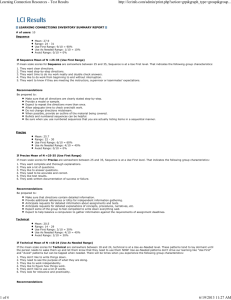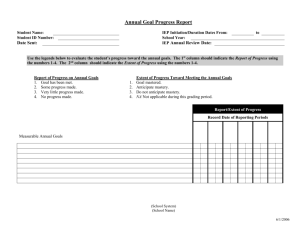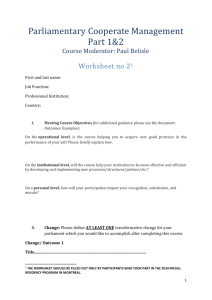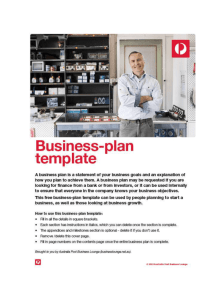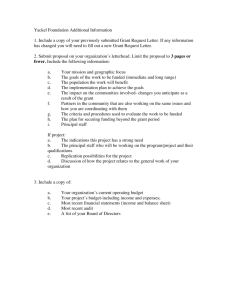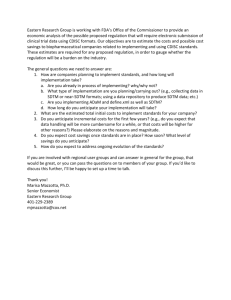Characteristics & Recommendations for Understanding Learning
advertisement
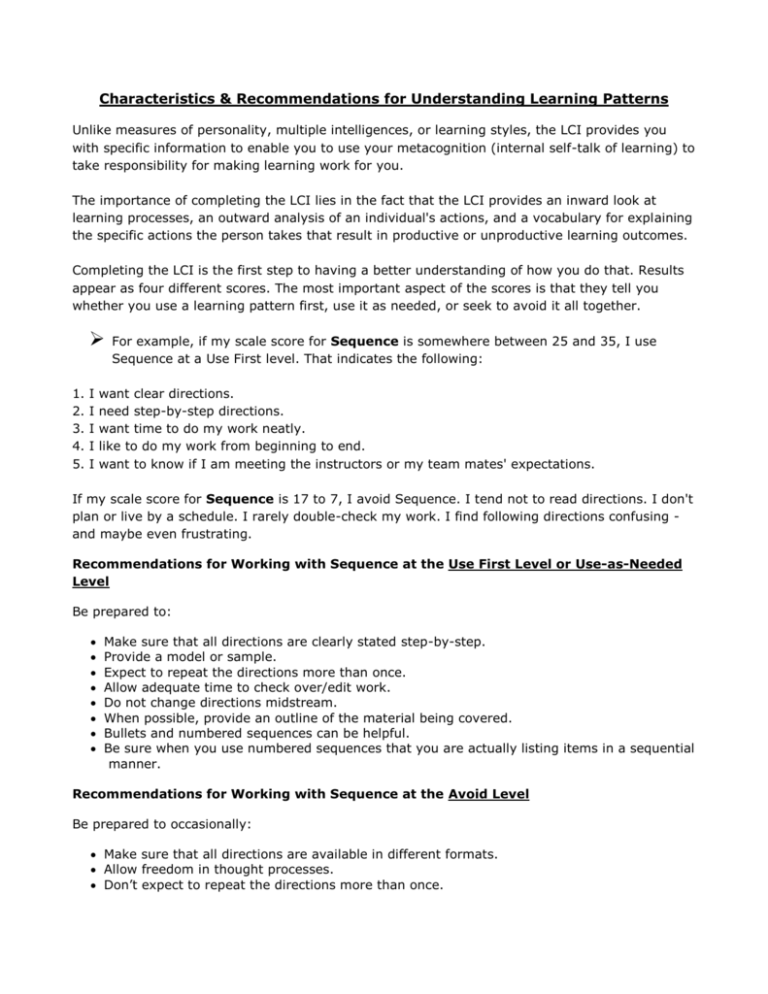
Characteristics & Recommendations for Understanding Learning Patterns Unlike measures of personality, multiple intelligences, or learning styles, the LCI provides you with specific information to enable you to use your metacognition (internal self-talk of learning) to take responsibility for making learning work for you. The importance of completing the LCI lies in the fact that the LCI provides an inward look at learning processes, an outward analysis of an individual's actions, and a vocabulary for explaining the specific actions the person takes that result in productive or unproductive learning outcomes. Completing the LCI is the first step to having a better understanding of how you do that. Results appear as four different scores. The most important aspect of the scores is that they tell you whether you use a learning pattern first, use it as needed, or seek to avoid it all together. 1. 2. 3. 4. 5. I I I I I For example, if my scale score for Sequence is somewhere between 25 and 35, I use Sequence at a Use First level. That indicates the following: want clear directions. need step-by-step directions. want time to do my work neatly. like to do my work from beginning to end. want to know if I am meeting the instructors or my team mates' expectations. If my scale score for Sequence is 17 to 7, I avoid Sequence. I tend not to read directions. I don't plan or live by a schedule. I rarely double-check my work. I find following directions confusing and maybe even frustrating. Recommendations for Working with Sequence at the Use First Level or Use-as-Needed Level Be prepared to: Make sure that all directions are clearly stated step-by-step. Provide a model or sample. Expect to repeat the directions more than once. Allow adequate time to check over/edit work. Do not change directions midstream. When possible, provide an outline of the material being covered. Bullets and numbered sequences can be helpful. Be sure when you use numbered sequences that you are actually listing items in a sequential manner. Recommendations for Working with Sequence at the Avoid Level Be prepared to occasionally: Make sure that all directions are available in different formats. Allow freedom in thought processes. Don’t expect to repeat the directions more than once. Reinforce the need for structure to communicate thoughts. Allow change in directions midstream. When possible, provide an outline of the material being covered to keep the groups focus. Short bullets can be helpful. Be flexible. 1. 2. 3. 4. 5. 6. I I I I I I If my scale score for Precise is somewhere between 25 and 35, I use Precision at a Use First level. That indicates the following: want complete and thorough explanations. ask a lot of questions. like to answer questions. need to be accurate and correct. like test results. seek written documentation of my success. If my scale score for Precise is 17 to 7, I avoid Precision. I rarely read for pleasure. I don't attend to details. Details are bothersome and boring. I find memorizing tedious and a waste of time. Much of the wordy conversation going on around me simply sounds like, "blah, blah, blah." Recommendations for Working with Precise at the Use First or Use-as-Needed Level Be prepared to: Make sure that directions contain detailed information. Provide additional references or URLs for independent information gathering. Anticipate requests for detailed information about assignments and tests. Anticipate requests for detailed explanations of concepts, procedures, narratives, etc. Expect some of the group to feel compelled to write down everything said. Expect to help balance a compulsion to gather information against the requirements of assignment deadlines. Recommendations for Working with Precise at the Avoid Level Be prepared to occasionally: Reinforce that assignments contain detailed information. Anticipate few questions about information on assignments and tests. Anticipate few requests for detailed explanations of concepts, procedures, narratives, etc. Expect some of the group to write little of what was presented. Expect to help balance little information gathering against the requirements of assignment. Short bullets can be helpful. Be flexible If my scale score for Technical is somewhere between 25 and 35, I use Technical at a Use First level. That indicates the following: 1. 2. 3. 4. 5. 6. I I I I I I don't like to write things down. need to see the purpose of what I am doing. like to work by myself. like to figure how things work. don't like to use a lot of words. look for relevance and practicality. If my scale score for Technical is 17 to 7, I avoid it. I don't get involved with taking things apart to understand how they work. I hire others to do building and repair work. I don't venture into the tool aisle. I problem solve with others not alone. Recommendations for Working with Technical at the Use First or Use-as-Needed Level Be prepared to: Make sure that the group understands the relevance of the assignment. When possible, demonstrate the practical application of the material to be learned. Provide opportunities to learn and to be assessed through hands-on activities and/or problem solving. Expect requests to demonstrate their knowledge in one-on-one situations. Anticipate that some would prefer to work alone. Anticipate that some will take minimal notes and will need coaching to meet your expectation for writing. Recommendations for Working with Technical at the Avoid Level Be prepared to occasionally: When possible, reinforce the importance of the practical application of the material to be learned. Provide opportunities to learn and to be assessed other than through hands-on activities and/or problem solving. Encourage the group to demonstrate their knowledge via research, reading and writing. Anticipate that some would prefer to work in groups or brainstorm. Anticipate that some will need coaching and discussion about assignments. Short bullets can be helpful. Be flexible 1. 2. 3. 4. 5. I I I I I If my scale score for Confluence is somewhere between 25 and 35, I use Confluence at a Use First level. That indicates the following: don't like doing the same thing over and over. see situations very differently than others do. like to do things my own way. don't like following the rules. enjoy taking risks. If my scale score for Confluence is 17 to 7, I avoid it. I think taking risks is foolish and wasteful. I would rather NOT make mistakes than having to learn from my mistakes. I am more careful and cautious in how I go about making life decisions. Recommendations for working with Confluence at the Use First or Use-as-Needed Level Be prepared to: Anticipate that some within the group will avoid reading or following directions; help them to understand when it is optional or imperative for them to do so. Make sure that there are opportunities to be assessed for risk-taking. Understand that some within the group will profit from making mistakes. Negotiate alternative ways for completing assignments and tasks. Anticipate that some within the group will have difficulty completing repetitive tasks. Anticipate that some within the group will generate ideas and grasp a larger picture, but may be perceived as not pulling his/her own weight with the tedious parts of a group project. Recommendations for Working with Confluence at the Avoid Level Be prepared to occasionally: Make sure that some within the group has opportunities to be assessed using traditional methods. Understand that some within the group will fear making mistakes. Provide examples for completing an assignment or task. Anticipate that some within the group will have difficulty completing unique or creative assignments. Anticipate that some group members will avoid taking risks. Be flexible. Patterns Used at the As Needed Range (18-24): Of course, if any of my patterns are in the 18-24 scale range, then I use these patterns as needed. I can use them when I need to. I just don't feel a great urgency to, especially if they fall into the 18-21 range. These patterns tend to lay dormant until I need to wake them up and let them know that I need to use them NOW! Used as needed patterns don't drive our learning like "Use first" and "Avoid" patterns. Dynamic If I use one or two of my patterns at the Use First level and then any other combination of the remaining patterns at either Avoid or Use As Needed then, I am a dynamic learner. This means that I require intentional effort in order to switch between learning patterns. Most people fall into this criteria. Person A: Sequence- 12 (avoids) Precision-32 (use first) Techncial-26 (use first) Confluent-19 (as needed) Bridge If I Avoid no patterns nor do I use any at a Use First level, then I am a bridge learner. I learn from listening to others and interacting with them. I am comfortable using all of the patterns. Sometimes I feel like a "jack of all trades and a master of none," but I also find I can blend in, pitch in, and help make things happen as a contributing member of the group. I weigh things in the balance before I act. I lead from the middle by encouraging others rather than taking charge of a situation. Approximately 1in 50 people fall into this criteria. Person B: Sequence-19 (as needed) Precision-24 (as needed) Technical-18 (as needed) Confluent-21 (as needed) Strong Willed If I use three or more patterns at the Use First level, I am a strong-willed learner. I am my own team. I prefer to work alone so that I can control the plan, the ideas, the talk, the decisions, the process, and the outcomes. I lead from out in front. Sometimes others find it hard to follow my lead. Approximately 1 in 10 people fall into this criteria Person C: Sequence-28 (use first) Precision-28 (use first) Technical-26 (use first) Confluent-21 (as needed) Each of these patterns operates within our interactive learning process at the same time! In other words, our learning process consists of a pattern of patterns. What makes us successful is being able to identify the expectations of the systems and relationships we work, live and play in while using our learning processes with intention to overcome challenges, including understanding and connecting with our instructors, supervisors, colleagues and ourselves.
